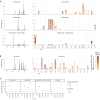Prospective mapping of viral mutations that escape antibodies used to treat COVID-19
- PMID: 33495308
- PMCID: PMC7963219
- DOI: 10.1126/science.abf9302
Prospective mapping of viral mutations that escape antibodies used to treat COVID-19
Abstract
Antibodies are a potential therapy for severe acute respiratory syndrome coronavirus 2 (SARS-CoV-2), but the risk of the virus evolving to escape them remains unclear. Here we map how all mutations to the receptor binding domain (RBD) of SARS-CoV-2 affect binding by the antibodies in the REGN-COV2 cocktail and the antibody LY-CoV016. These complete maps uncover a single amino acid mutation that fully escapes the REGN-COV2 cocktail, which consists of two antibodies, REGN10933 and REGN10987, targeting distinct structural epitopes. The maps also identify viral mutations that are selected in a persistently infected patient treated with REGN-COV2 and during in vitro viral escape selections. Finally, the maps reveal that mutations escaping the individual antibodies are already present in circulating SARS-CoV-2 strains. These complete escape maps enable interpretation of the consequences of mutations observed during viral surveillance.
Copyright © 2020 The Authors, some rights reserved; exclusive licensee American Association for the Advancement of Science. No claim to original U.S. Government Works.
Figures




Update of
-
Prospective mapping of viral mutations that escape antibodies used to treat COVID-19.bioRxiv [Preprint]. 2020 Dec 1:2020.11.30.405472. doi: 10.1101/2020.11.30.405472. bioRxiv. 2020. Update in: Science. 2021 Feb 19;371(6531):850-854. doi: 10.1126/science.abf9302. PMID: 33299993 Free PMC article. Updated. Preprint.
References
-
- Caskey M., Klein F., Lorenzi J. C. C., Seaman M. S., West A. P. Jr.., Buckley N., Kremer G., Nogueira L., Braunschweig M., Scheid J. F., Horwitz J. A., Shimeliovich I., Ben-Avraham S., Witmer-Pack M., Platten M., Lehmann C., Burke L. A., Hawthorne T., Gorelick R. J., Walker B. D., Keler T., Gulick R. M., Fätkenheuer G., Schlesinger S. J., Nussenzweig M. C., Viraemia suppressed in HIV-1-infected humans by broadly neutralizing antibody 3BNC117. Nature 522, 487–491 (2015). 10.1038/nature14411 - DOI - PMC - PubMed
-
- Kugelman J. R., Kugelman-Tonos J., Ladner J. T., Pettit J., Keeton C. M., Nagle E. R., Garcia K. Y., Froude J. W., Kuehne A. I., Kuhn J. H., Bavari S., Zeitlin L., Dye J. M., Olinger G. G., Sanchez-Lockhart M., Palacios G. F., Emergence of Ebola virus escape variants in infected nonhuman primates treated with the MB-003 antibody cocktail. Cell Rep. 12, 2111–2120 (2015). 10.1016/j.celrep.2015.08.038 - DOI - PubMed
-
- Simões E. A. F., Forleo-Neto E., Geba G. P., Kamal M., Yang F., Cicirello H., Houghton M. R., Rideman R., Zhao Q., Benvin S. L., Hawes A., Fuller E. D., Wloga E., Pizarro J. M. N., Munoz F. M., Rush S. A., McLellan J. S., Lipsich L., Stahl N., Yancopoulos G. D., Weinreich D. M., Kyratsous C. A., Sivapalasingam S., Suptavumab for the prevention of medically attended respiratory syncytial virus infection in preterm infants. Clin. Infect. Dis. ciaa951 (2020). 10.1093/cid/ciaa951 - DOI - PMC - PubMed
Publication types
MeSH terms
Substances
Grants and funding
LinkOut - more resources
Full Text Sources
Other Literature Sources
Medical
Research Materials
Miscellaneous

